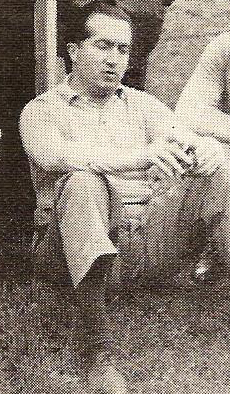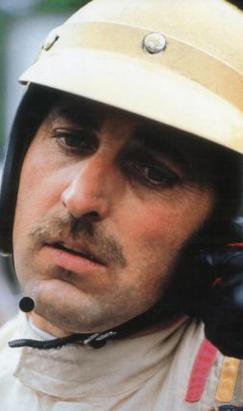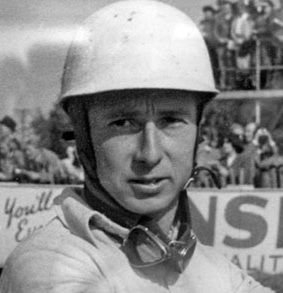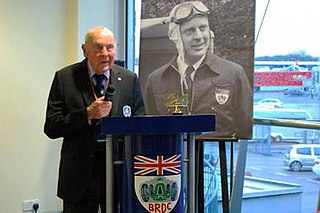
George Edgar Abecassis was a British racing driver, and co-founder of the HWM Formula One team.

The 1955 Formula One season was the ninth season of FIA Formula One motor racing. It featured the sixth World Championship of Drivers, which was contested over seven races between 16 January and 11 September 1955. The season also included several non-championship races for Formula One cars.

The 1952 Formula One season was the sixth season of FIA Formula One motor racing. It featured the 3rd World Championship of Drivers, which was contested over eight races between 18 May and 7 September 1952. The season also included several non-championship races and a separate East German Championship.

The 1951 Formula One season was the fifth season of FIA Formula One motor racing. It featured the second World Championship of Drivers, which was contested over eight races between 27 May and 28 October 1951. The season also included several non-championship races for Formula One cars.

Peter John Collins was a British racing driver. He was killed in the 1958 German Grand Prix, just weeks after winning the RAC British Grand Prix. He started his career as a 17-year-old in 1949, impressing in Formula 3 races, finishing third in the 1951 Autosport National Formula 3 Championship.

Roy Francesco Salvadori was a British racing driver and team manager. He was born in Dovercourt, Essex, to parents of Italian descent. He graduated to Formula One by 1952 and competed regularly until 1962 for a succession of teams including Cooper, Vanwall, BRM, Aston Martin and Connaught. Also a competitor in other formulae, he won the 1959 24 Hours of Le Mans in an Aston Martin with co-driver Carroll Shelby.
Charles Anthony Standish Brooks was a British racing driver. Also known as the "Racing Dentist", he participated in 39 Formula One World Championship Grands Prix, competing for the first time on 14 July 1956, and achieved six wins, 10 podium finishes and 75 career points. He was third in the World Drivers' Championship in 1958 with Vanwall and second in 1959 with Ferrari. He also scored the first win by a British driver in a British car in a Grand Prix since 1923, driving a Connaught at Syracuse in 1955 in a non-championship race. After the death of Stirling Moss in 2020 and before his own death in 2022, Brooks was the last surviving Grand Prix winner from the 1950s.
William Simpson Aston was a British racing driver who participated in three World Championship Grands Prix, in 1952 when the championship was run to Formula Two rules, for his own team Aston Butterworth.
Élie Marcel Bayol was a French racing driver who raced in Formula One for the O.S.C.A. and Gordini teams. Bayol also raced sports cars, mostly driving DB-Panhards for the Deutsch Bonnet works team including winning the 750cc class and Index of Performance at the 1954 24 Hours of Le Mans.

Ian Macpherson McCallum Stewart was a British racing driver from Scotland.

Joseph Théodule Marie Schlesser was a French Formula One and sports car racing driver. He participated in three World Championship Grands Prix, including the 1968 French Grand Prix in which he was killed. He scored no championship points. He was the uncle of Jean-Louis Schlesser who himself became a Formula One driver in the 1980s.

Lance Noel Macklin was a British racing driver from England. He participated in 15 Formula One World Championship Grands Prix, debuting on 18 May 1952. He was infamously involved in the 1955 Le Mans disaster, starting the initial chain reaction.
Robin Montgomerie-Charrington was a British racing driver from England. He took up 500cc Formula 3 in 1950, achieving modest results through '50 and '51. He participated in one Formula One World Championship Grand Prix, the European Grand Prix at Spa, Belgium, on 22 June 1952. He retired his Aston Butterworth with "engine trouble" after 17 laps and scored no World Championship points.
Rudolf Krause was a racing driver from East Germany.

Reginald Parnell was a racing driver and team manager from Derby, England. He participated in seven Formula One World Championship Grands Prix, achieving one podium, and scoring a total of nine championship points.
Horace Gould was a British racing driver from Bristol.

Peter Douglas Conyers Walker was an English racing driver. He was born in Huby, Yorkshire and died in Newtown, Worcestershire. He proved a strong driver in most disciplines, but was most adept in sports cars, winning the 1951 24 Hours of Le Mans race, and the Goodwood Nine-Hours in 1955. He effectively retired after a crash in 1956 left him with serious injuries.

Eric David Thompson was a British racing driver, book dealer and insurance broker. He participated in sports car racing between 1949 and 1955 taking his greatest success by finishing third in the 1951 Les 24 Heures du Mans and took part in the 1952 RAC British Grand Prix.
Rob Walker Racing Team was a privateer team in Formula One during the 1950s and 1960s. Founded by Johnnie Walker heir Rob Walker (1917–2002) in 1953, the team became F1's most successful privateer in history, being the first and only entrant to win a World Championship Formula One Grand Prix without ever building their own car.

The BRM Type 15 was a Formula One racing car of the early 1950s, and the first car produced by British Racing Motors. The car was fitted with a revolutionary and highly complex supercharged 1.5-litre British Racing Motors V16 which produced considerably more power than any of its contemporaries.













